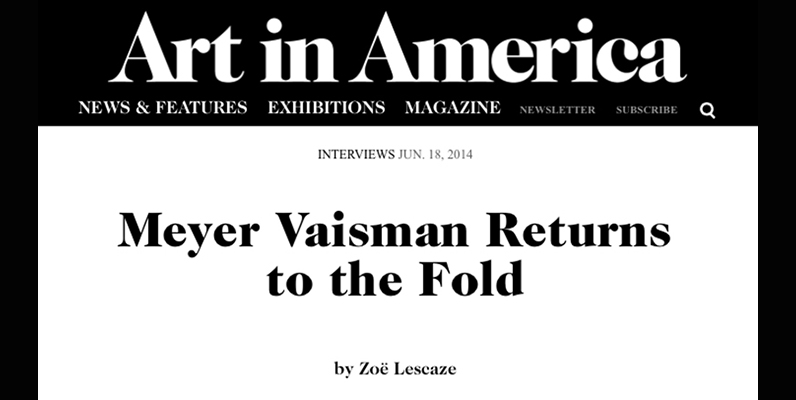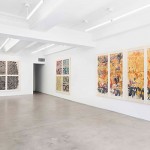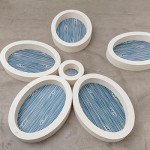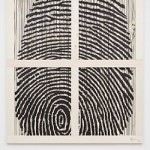Meyer Vaisman burst on to New York’s downtown art scene in 1980, and swiftly became one of its brightest stars.
The Venezuelan-born artist was hailed as one of the «Fantastic Four» alongside Ashley Bickerton, Jeff Koons and Peter Halley, constituting a quartet credited with leading the Neo-Geo movement. Experimenting particularly with commercial and photomechanical reproduction, Vaisman explored questions of authorship while infusing his multimedia work with acute irony and humor. He famously co-founded the East Village gallery International With Monument, which became legendary as the Neo-Geo nexus, exhibiting then-emerging artists such as Sarah Charlesworth, Richard Prince and Laurie Simmons, among many others.
These days, the processes Vaisman pioneered, such as inkjet printing, are everywhere, but his name is not as well known as those of his former peers. He left New York’s art world in 2000, decamping for Barcelona after a final show at Gavin Brown’s Enterprise. The exhibition featured a life cast of Vaisman’s fleshy former therapist and a dark-colored harlequin suit made of clothing belonging to his parents. The installation, with its Freudian undertones, was something of an omen. Vaisman experienced a series of psychiatric and emotional breaks that ultimately led him to a newfound spirituality.
Now, Vaisman is back with a show at the Lower East Side gallery Eleven Rivington, which began representing him in February. After teasing audiences with new work at the NADA art fair in May, the gallery has devoted both of its branches to Vaisman’s solo show «In The Vicinity of History, 5774» (through July 3), the title of whichrefers to the Hebrew calendar.
On the occasion of his New York comeback, Vaisman, 54, corresponded with A.i.A. via e-mail from Barcelona to discuss his new work and how he has spent the last 14 years abroad.
ZOË LESCAZE How does it feel to be showing in New York City again?
MEYER VAISMAN It feels good, but it could feel great if I were there. Issues with the Spanish immigration authorities prevented me from going. New York City, in particular the East Village and Lower East Side, was my playground for years. I hear it’s gone through quite the transformation, so I’m curious. Some of my friends say I’d hate it.
LESCAZE Have you been creating work consistently since moving to Spain, or did you stop for a while?
VAISMAN I moved to Barcelona to do nothing. Mind you, Catalans are very hard-working, but the city itself, being on the Mediterranean, lined with palm trees and filled with parakeets, makes you feel like taking an extended vacation. So I hung around and on Saturday nights I’d hit the clubs—which are very good—drop X and dance till sunrise. I had had it with the art world.
LESCAZE You became more religious after arriving in Barcelona. Can you talk about what led to this?
VAISMAN I began feeling very good, very enlightened even on days when I wasn’t consuming [drugs], and that drove me to seek a Bible, which was a big mistake. Only later I got a Tanakh, which contains the Torah and the sacred books. By the time I was immersed in reading, I had stopped all stimulants. I thought I had heard the voice of HaShem, God, who directed me to certain passages in the Torah that pertained to my life as I was living it at the time. For instance, I was living with a man and I ended that. I thought I was Mashiach, Messiah, and told psychiatrists so. They sedated me heavily and kept me locked in for six weeks.
LESCAZE How has practicing Judaism affected your art?
VAISMAN I no longer represent humans or animals because it is forbidden. That drove me naturally to abstract art. I’ve almost always worked abstractly, so working exclusively abstractly has come naturally. I have found the experience very pleasant. Also, it is important to know that my involvement in these works is minimal. I have an assistant who can almost read my mind, and follows my directions well. The work is done via the web and e-mail. I make suggestions for changes and, when I feel it’s finished, she readies it for the printer. I find these artists with 120 assistants beyond ridiculous. I like to be alone and have designed my life to fulfill that. I see friends, yes, on occasion. But I’m not a slave to my art nor anyone else.
LESCAZE How is your process different from that of artists with legions of assistants?
VAISMAN My assistant and I work on a micro scale. Two computers: she from her home, I from mine. That’s it. Two people. Small, humble, nice. I’ve had up to five assistants before and that seemed like a lot. Now having hundreds, that’s running a corporation and the art that’s produced there looks like that. Not my thing, that’s all. But I know it makes a few players feel good.
LESCAZE Do you feel any lasting artistic affinity with Koons, Bickerton or Halley, the artists you came up with in the 1980s, especially as we prepare for Koons’s upcoming Whitney Museum survey?
VAISMAN I will have much to say abut this in the future, but I want to advance that everything that Jeff Koons has made since, and including, the «Luxury and Degradation» show, which International With Monument mounted in 1986, I deplore.
LESCAZE After a period of not making art, what prompted you to start again? What made you decide to join Eleven Rivington?
VAISMAN It was simply a change in medication. I was being given something which would not let me think properly, and which produced other nasty physical side effects. In regards to Eleven Rivington, I had had another suitor, but they had other ideas, and Augusto [Arbizo, the director at Eleven Rivington] made the effort to come see me in Barcelona. I appreciated that gesture of seriousness.
LESCAZE Your signature is a major motif in the new work. Can you talk about its significance?
VAISMAN My work has always had to do with self-referentiality, so in this series of works I used my signature repeatedly until it means nothing but a gesture that covers everything, and I also used my fingerprint.
LESCAZE At least one work references Cy Twombly, borrowing one of his compositions. Why did you choose to appropriate Twombly in particular?
VAISMAN I didn’t appropriate Twombly. I did a mirror image of one of his paintings with my signatures. His work is beautiful, and that attracted me, but also his life story. He was a bisexual who chose to get married and have a family, and I relate to that. I have struggled with bisexuality myself, and for me it is a great burden. Right now I am alone, but I would do things as Twombly did even though I know many in the LGBT [community] would not look kindly on this, even while using «diversity» as a battle cry.
LESCAZE But the B in that acronym stands for bisexual. Are there not many other men whose bisexuality manifests in the way it did for Twombly, or for you?
VAISMAN I couldn’t answer that with any degree of exactitude.
LESCAZE Many of your new works expose the wooden supports of traditional paintings, and it’s as though we are viewing the backs of stretched canvases. What led you to reveal these beams?
VAISMAN I’ve been interested in skeletons ever since I used to travel in the southwestern United States and would look at people’s rock and bone gardens. The stretcher bar is the painting’s skeleton, and when an artist shows the stretcher bars I interpret it as an act of humbleness. Velázquez did it in Las Meninas, Rembrandt also. More contemporary examples would be Johns and Lichtenstein. In my case, it is taken a bit further, since everything is upside down, right side up, inside out, stretched, compressed, etc. It was a way to talk about a world that’s not quite right.
http://www.artinamericamagazine.com/news-features/interviews/meyer-vaisman-returns-to-the-fold/



